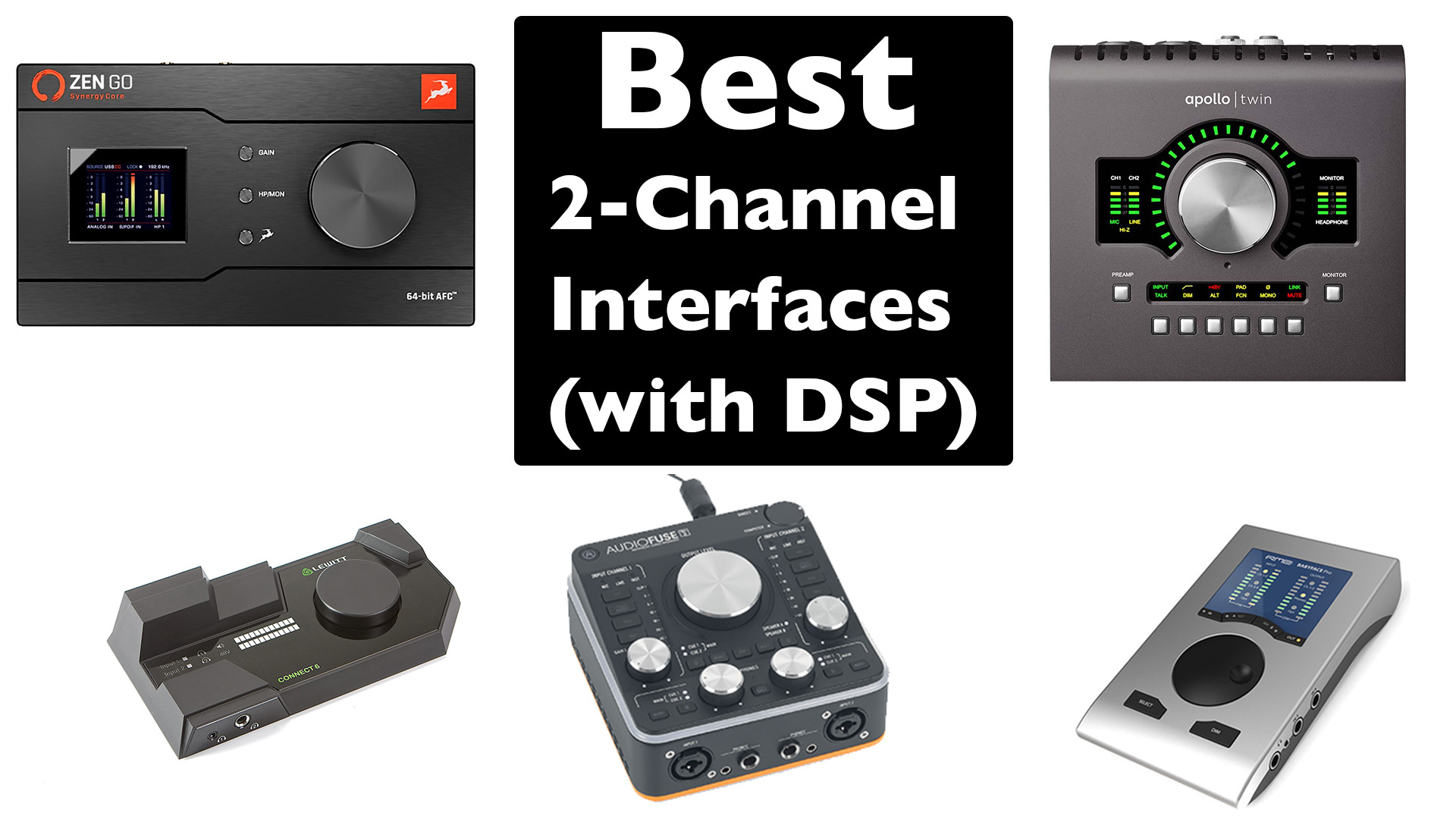The Best 2 Channel Audio Interfaces with DSP in 2023
Introduction
Not everyone needs a recording interface with a large channel count. Whether you’re just starting out in a bedroom studio, are a musician on the road, or a professional who handles mostly mixing and overdubs, there are many cases in which having just a couple high quality inputs is the ideal. The best 2 channel audio interfaces with DSP help to streamline your workflow in a lot of ways.
But don’t think that just because an interface only has a few inputs it has to be inferior. All the interfaces on this list offer great sound quality, built in effects and DSP processing, and many of them include great expandability options, so they can serve as a long-term centerpiece for an ever-expanding studio.
Interfaces with onboard DSP effects offer a lot of advantages. First and foremost, they take some of the processing load off of your computer allowing for more audio processing and bigger track counts with fewer crashes—and without having to buy the most expensive new computer on the market.
Their ability to provide latency-free processing while recordings means you can track through them, committing to sounds on the way in. In addition to freeing up processing power during the mix, this allows performers to hear themselves through a more polished audio chain without any audible delay, increasing their confidence, and potentially, the quality of their performances.
With DSP-powered interfaces, you also get access to officially licensed plugins that are usually among the highest quality available, so you don’t have to worry about managing a bloated library of dozens of plugin brands.
Let’s check out some of the best 2 channel interfaces with DSP on the market today and determine where each of them excels.
Antelope Audio Zen Go Synergy Core (Best Overall Package for 2 Channel Interface with DSP
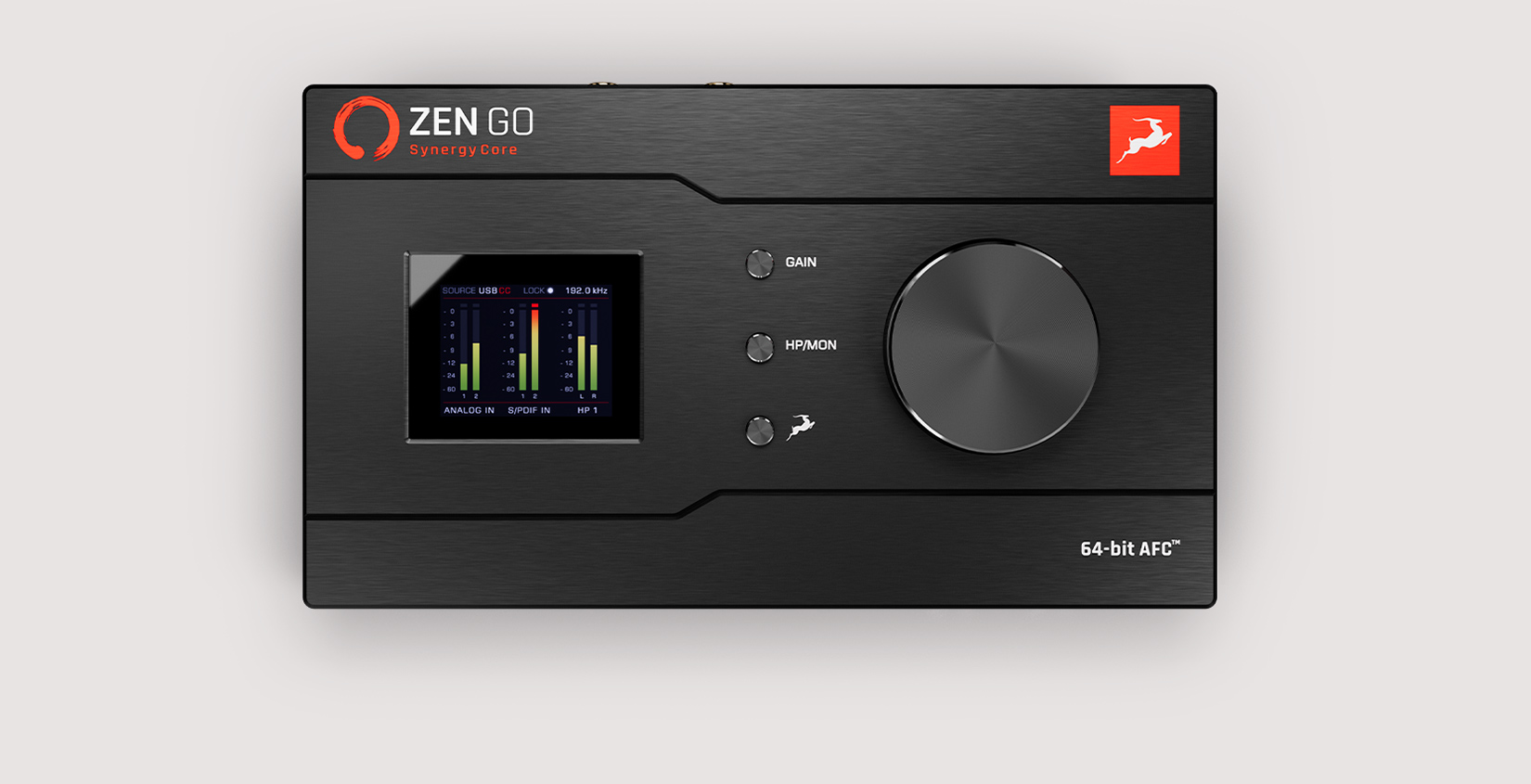
Antelope Audio Zen Go Synergy Core
Buy it new on Sweetwater, B&H, Thomann, or Amazon. Look for deals on Reverb.
It’s well-known that Antelope Audio makes some of the best large format interfaces in the world of professional audio. But in recent years, they’ve stepped into the smaller channel count category without skimping on the best-in-class conversion and ultra-clean preamps that made them so renowned in the first place.
The AD/DA conversion on the Zen Go Synergy Core provides 127dB of headroom with some of the highest level of detail in a two-channel interface. Their dual discrete linear preamps provide 65dB of gain with switchable inputs for line, mic, and Hi-Z modes designed to sound like they came from a high-end console. And, Antelope’s 64-bit Acoustically Focused Clocking is meant to give the soundstage superior separation and width, just like you’ll find in their dedicated outboard clocking hardware.
It comes with a robust suite of Synergy Core effects, many of them meticulously modeled after classic analog gear. The included library features mic preamps, EQs, compressors, amp and cabinet sims, and the company’s signature AuraVerb reverb.
In total there are 37 effects included with the interface, with another 50 optional expansion effects available. Expansion effects include models of Grove Hill’s and Gyratec EQs, as well as third party processors like Antares Auto-Tune. All DSP effects run directly through the interface and can be used during every phase of the recording process without latency or hogging your computer’s resources.
A built-in loopback feature makes it a perfect choice for streaming, podcasting, and broadcasting online. Session recall allows you to snapshot your settings and load them back instantly at any time.
It’s bus powered through USB-C or Thunderbolt 3 and runs on Windows and Mac systems. This makes it ideal for mobile recording and field work. The design is sleek with just a few controls on the faceplate, and some of the clearest digital meters available on an interface of this size. The rear offers combination XLR/TRS connections and S/PDIF for connecting it to other hardware.
The one potential drawback with the onboard Antelope effects is that they run in a separate Antelope application, rather directly in your DAW. This doesn’t matter when you are recording, but using them at the mixing stage is slightly more complex than just inserting a plugin, and requires an extra step. Not dealbreaker at all, but a mild inconvenience compared to just clicking on an effect from your plugin menu.
Fortunately, Antelope Audio has started to make some of its effects available natively so they will run directly in your DAW. But if you want super seamless DSP powered effects at the mixing stage, see our next entry on this list.
Universal Audio Apollo Twin (Best DSP Effects and Software Features)
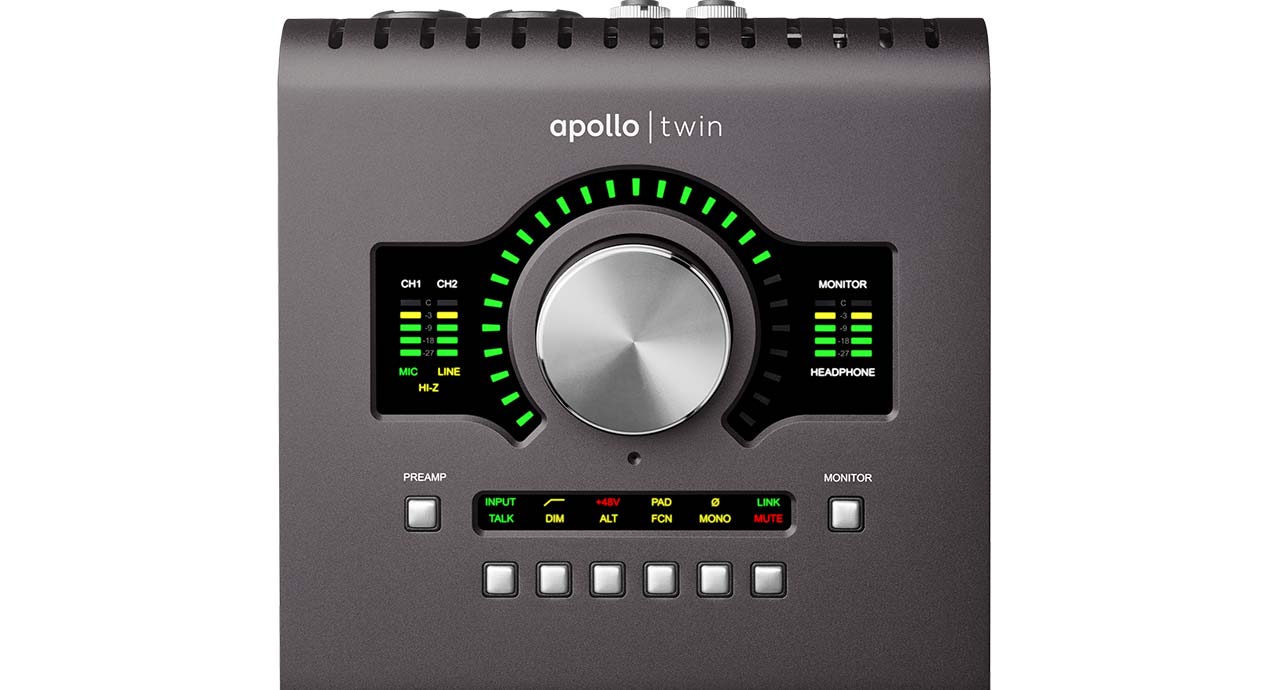
Universal Audio Apollo Twin
Buy it new on Sweetwater, B&H, Thomann, or Amazon. Look for deals on Reverb.
Universal Audio is celebrated for their stellar interfaces and plugins, and the DSP powered Apollo line offers the best of both worlds.
The Apollo Twin mk II features two Unison mic preamps that give you real-time access to legendary emulations from API, SSL, Neve, Manley, and Universal Audio themselves — many of them officially approved and licensed by some of the biggest brands in the hardware domain.
While the interface itself features excellent standalone sonic quality, the DSP effects are where UA truly outshines the competition. In each of the hardware emulations, the circuit topology is accurately modeled, including input impedance, sweet spots in the gain stage, and how the components interact within the circuit. And using these DSP-powered plugins in your DAW is incredibly easy—it’s as simple as just inserting a plugin on your tracks. Not all of Universal Audio’s competitors have caught up like this yet.
The DSP effects are insanely accurate, and model classic compressors like the LA-2A and 1176, EQs like the Pultec, the UA 610-B tube preamp and more. It comes with a suite of vintage guitar amps too, so you can digitally plug into a Marshall Plexi and Super Lead, Fender Tweed, and an Ampeg bass amp, among others. All of this together puts a digital studio full of boutique gear at your fingertips.
As for the conversion, both A/D and D/A are designed to provide increased dynamic range and total harmonic distortion (THD) to give you accurate clarity, depth, and accuracy of the analog units they’re modeling.
The face of the unit provides a streamlined workflow with digital metering, phantom power, pad, mono button, alt speaker switch for A/B monitoring, and a built-in talkback mic. The rear of the unit has two combination inputs, dual TRS line output, and optical in for integrating other gear. So no matter how you have your gear routed, the Apollo Twin will find a place in your setup.
If you think you might have to expand the channel count in the future, you can chain up to four Apollos and six UAD-2 pieces of hardware together through Thunderbolt to easily expand your setup with your needs.
Everything about the Apollo is as sleek, sexy, and sophisticated as you can find in a two-channel interface with onboard DSP. Even the unboxing is a great experience. It’s an excellent investment, and a perfect starting point for building your studio, proven to give professional results.
Audient Sono (Best for Guitarists)
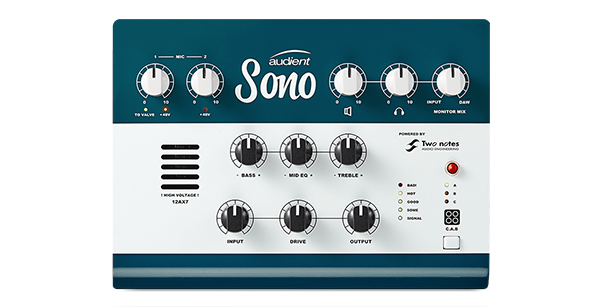
Audient Sono
Buy it new on Sweetwater, B&H, Thomann, or Amazon. Look for deals on Reverb.
If you’re a guitarist looking for an interface designed specifically for the instrument, the Sono is exactly that. Audient even designed it to look like a guitar processor, with a layout and aesthetic that any guitar player will find familiar.
Where it really shines is with the cabinet modeling from Two Notes Torpedo. This lets you dial in the tone of a mic’d up cab from Fender, Marshall, and more, all recorded in a high-end studio. You get parameter control over the model and placement of the mic, and can even select between different types of rooms. Once you find the tone you’re chasing, you can save up to three presets on the face of the unit for instant recall.
Audient is known for using the same quality preamps in their smaller interfaces that they do in their large frame consoles. Two console-quality Class A mic preamps provide a clear sound with plenty of punch. There’s also a tube guitar preamp with a 12AX7 tube and 3-band EQ, which does a great job of complementing the cabinet and room emulations.
You can expand it to up to 10 inputs through ADAT, and use it to reamp without needing a dedicated reamp box. This makes it easy to blend real guitar amps with the models. At only $299 it’s an amazing value for the price point and comes in handy if you have noise restrictions in your space and want to keep things quiet.
For the guitarist that needs something simple but sounds anything but, Audient offers what you need in the Sono.
Arturia AudioFuse rev2 (Best Built-In I/O Options)
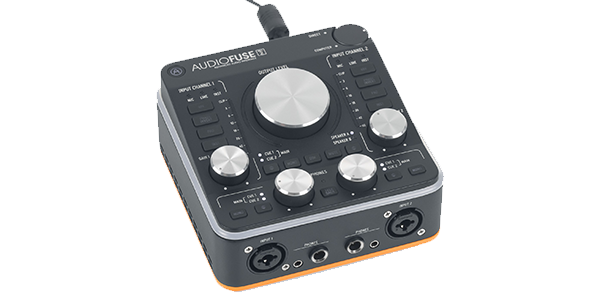
Arturia AudioFuse rev 2
Buy it new on Sweetwater, B&H, Thomann, or Amazon. Look for deals on Reverb.
Arturia made some serious upgrades to the AudioFuse in rev2, making it one of the best 2 channel interfaces with DSP. It runs on the latest generation of their converters at up to a 24-bit/192kHz sample rate. This means that you can record a symphony at the same quality as a hip-hop artist.
The pair of DiscretePRO mic preamps lend a little analog flavor in an often cold, digital recording world. And as for the DSP, you get access to Arturia’s full Creative Suite. It includes a trio of channel strips, a variety of filters, compressors and effects, and the Analog Lab Intro collection of virtual instruments to get you going right out of the box.
The control scheme might seem daunting at first, but it’s laid out logically and is surprisingly easy to learn and use. Each input channel has phantom power, phase invert, pad, and Hi-Z option with dedicated gain knob. The center knob sets output level. You can dim, mute, or flip the master into mono to make sure your mixes translate across any type of playback device. Separate monitor and master mix channels provide comprehensive monitoring and playback options.
Routing won’t be an issue with the AudioFuse. These include two line inputs in addition to the mic pres, two insert points for connecting additional gear, two phono preamps, two headphone outputs, and two sets of speaker outs to easily A/B your productions. ADAT lets you add additional I/O, and MIDI and Word Clock I/O give you an extra level of control over Arturia’s robust virtual instrument collection or your own MIDI outboard units.
AudioFuse might not have the extensive DSP options that others on this list do, but considering the character of the effects, how powerful the I/O is, the build quality, and the native expandability, it’s a great choice to be the centerpiece of any studio.
Lewitt Connect 6 (Best for Streamers and Content Creators)
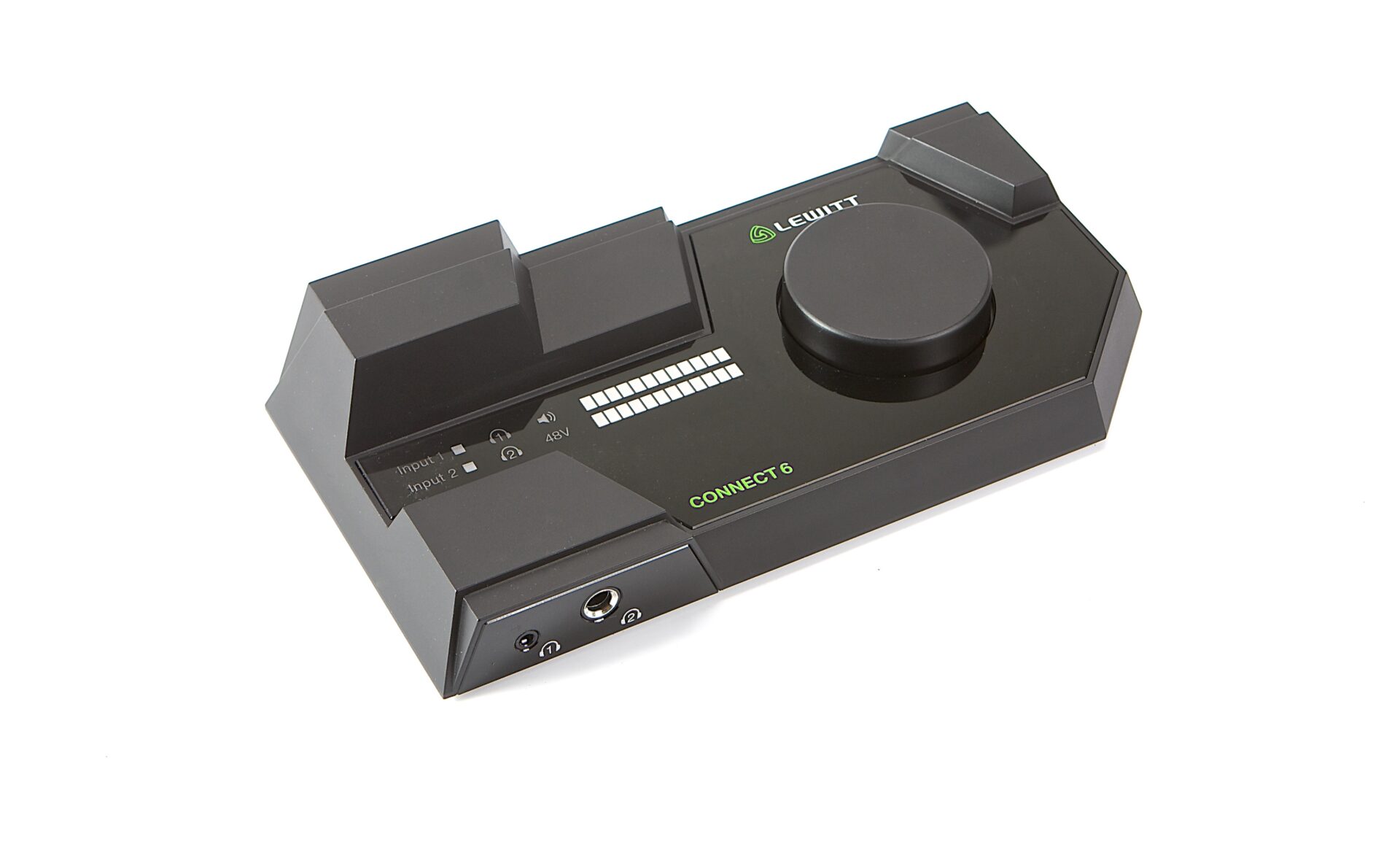
Lewitt Connect6
Buy it new on Sweetwater, B&H, Thomann, or Amazon. Look for deals on Reverb.
It turns out that Lewitt doesn’t just make great sounding, affordable microphones. They’ve expanded into the interface game, and their Connect 6 is the most unique option on this list. The two preamps offer up to 72dB of gain with low-noise, and while it’s useful for music production, it’s ideal for streamers due to how well it integrates with mobile devices like tablets and smartphones.
The onboard DSP is simple but effective. It includes 4-band EQ on each channel, compression, a maximizer, and expander. A unique Auto Setup function automatically selects settings for the sound source you’re recording. With two master mixes, the Control Center gives you full digital control over routing, one of the reasons it’s perfect for content creators.
It’s a great mobile interface that can integrate with Android, iOS, and iPads in addition to traditional DAWs and recording systems. You can send the audio directly out to platforms like TikTok, Instagram, and other social media networks. It even charges your device while you use it!
RME Babyface Pro (Best High End Portable Interface with DSP)
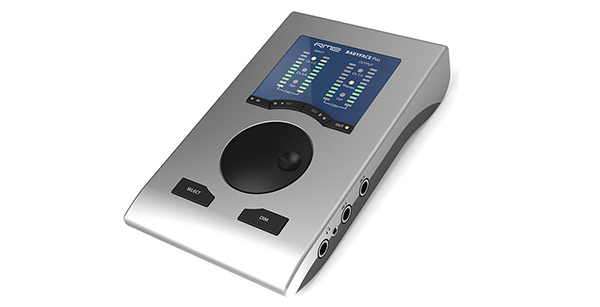
RME Babyface Pro
Buy it new on Sweetwater, B&H, Thomann, or Amazon. Look for deals on Reverb.
The Babyface Pro USB bus-powered interface comes in a small, durable enclosure making it a top choice if you need something easily portable without skimping on quality. It connects through USB2.0 and 3.0 but is compatible with Thunderbolt/ USB-C through the included cabling. This makes it great for legacy devices and older computers.
For such a small unit, the hardware specs are impressive with high end preamps, conversion and clocking in an incredibly sleek and compact package.
The two preamps are digitally controlled and each channel offers a high-pass filter, 3-band EQ, echo, and reverb. TotalMix FX onboard processing runs on a dual-DSP system that uses one chip for the monitor mix while the other handles the zero latency effects processing. It also provides a staggering 288-channel mixer that lets you route signals exactly like you want.
In addition to the DSP, it comes with the Babyface Pro Bundle that includes plugins from companies like Brainworx, Modartt, GG Audio, and Gig Performer. No matter what phase of the music production process you’re performing, or if you’re working with film and TV post sound, the Babyface Pro is one of the best 2 channel audio interfaces with DSP and a complete, mobile toolkit.
Byline:
Brandon Stoner is a lifelong musician and audio engineer who owns more guitars than anyone needs. As a lover of all things writing and music technology, he crafts every piece with his dog Max on his lap.
Please note: When you buy products through links on this page, we may earn an affiliate commission.







